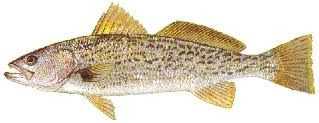Squeteague

Species Details
Cynoscion Regalis
Sciaenidae
Perciformes
Onshore, Nearshore, Shallows
12 - 20 lbs.
14" - 39"
Squeteague (Cynoscion regalis) Fish Description
More popularly known as Weakfish, the Squeteague is a sea trout that can be easily recognized despite being similar to the bluefish in color and fin shape. It is also known as Bastard Weakfish, Bastard Trout, Chickwick, Common Weakfish, Gray Squeteague, Grey Trout, and Grey Weakfish.
The Squeteague’s body is olive green in color, darker on the upper part, and lighter below. It generally appears iridescent and freckled with gold, green, copper, or lavender both on its sides and back. The area above its lateral line and its sides have dark green, black, or bronze spots. The Squeteague’s body resembles a freshwater trout; it is a bit flattened and streamlined. It has a large mouth with a slightly protruding snout and two canine teeth on the upper jaw.
Diet and Size
The Squeteague forms a fairly small school that goes near the water’s surface to capture food. The Squeteague is an active predator that can swim rather fast. Its favorite meals include crabs, worms, mollusks, anchovies, schools of Atlantic menhaden, killifish, and other small fishes. The Squeteague approaches its prey slowly then attacks it violently with its mouth wide open. On the other hand, the Squeteague is preyed upon by the striped bass, the dusky shark, and the bluefish.
The Squeteague can grow from 14 to 26 inches long. It can weigh up to 20 pounds.
Interesting Facts About the Squeteague
- The Squeteague is called the “Weakfish” because of its weak muscles in the mouth, making it easily break free from the hook and escape.
- The Squeteague, which belongs to the drum family, can produce a drumming or croaking sound. This is an important signal during their spawning season. The contraction of the Squeteague’s abdominal muscles against its swim bladder makes this distinct drumming sound.
- The Squeteague lacks a sensory barbel chin which is present in its cousins from the drum family; this barbel is supposed to aid in bottom-feeding.
- Squeteague is the state fish of Delaware.
Fishing Techniques
The Squeteague is abundant from April to October. Anglers capture the Squeteague both for recreational and commercial purposes. The population of Squeteague has been declining due to bycatch especially in shrimp trawls. Thus, regulations (including minimum size limits, use of bycatch reduction gear, commercial creel limits, etc.) have been imposed when fishing for this species.
Capturing the Squeteague may prove a challenging task because it is shy and fussy, making it a good game fish for anglers.
To catch them, anglers must fish from waters with temperatures ranging from 50 °F to 65 °F since the Squeteague breed in such conditions.
Anglers must take note of the limitations and season for harvesting the Squeteague. In New Jersey, every recreational angler can only catch one Squeteague at any time of the year, provided it is 13 inches or longer.
Habitat and Distribution
This species of fish prefers salty marsh creeks, estand open and shallow waters along sandy shores. They are often found nearshore, especially estuaries and bays. The young Squeteague generally live in deeper waters including rivers; they love sandy and grassy bottoms. Many of them are found nearshore in the Atlantic Ocean, serving as their nursery. On the other hand, the adult Squeteague abound in their feeding areas which include eelgrass habitats, oyster reefs, and rocky areas. The homes of Squeteague are threatened by the conversion of coastal areas to agricultural lands.
The Squeteague is generally found from Canada to northern Florida, as well as the eastern coast of North America. They also thrive in the Atlantic Ocean, Chesapeake Bay and the Gulf of Mexico.





